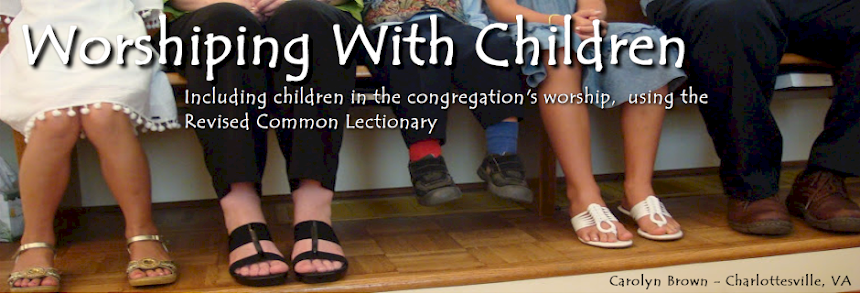With World Communion this
Sunday most of us are paying particular attention to the sacrament. Go to World Communion (Year C) for ideas about
celebrating communion on the day when Christians around the world celebrate particularly
aware of each other. But, also think for
a minute about celebrating communion beyond this special day. The sacrament is more than simply eating and
drinking. The eating and drinking is
surrounded by words and actions that we often do not explain to children (or
adult worshipers). For these children
the Great Prayer of Thanksgiving becomes “that long prayer before communion”
and so forth. It is possible to raise up
one part of the ritual before the sacrament at different times of the year to
inform and enrich the children’s participation. For example,
ØWalk through the words of the Invitation to the Table
phrase by phrase. Point out who is
included. One minister invited the
children forward for this conversation, then had them give the invitation to
the congregation. She said a phrase. The children echoed it. At the end they went back to their seats to participate. (This would actually be a good one for World
Communion Sunday emphasizing the inclusion of people all around the world.)
ØThe opening of many communion rituals is the responsive, “The Lord be with you…” Explain to the children that this is the call to communion and is like a second call to worship. We are telling God and ourselves that we are really here and paying attention. Practice it together. If you have called the children forward for this, send them back to their seats before doing it “for real” with the whole congregation.
ØTo unpack the praise following “joining our voices with the servants around heaven’s throne and with the faithful of every time and place, who forever sing to the glory of your name,” list a few well known biblical characters, someone from church history, and a local hero/ine. Invite worshipers to add the names of their ancestors – grandparents and other family members who have died. Create a mental picture of all these people worshiping God together. Then practice your part in the song and get ready to sing it. (This is a great addition to All Saints Day communion.)
ØThe second part of the Great Prayer of Thanksgiving briefly tells the story of Jesus. The congregation responds with a summary of that summary. Walk through the Jesus part of the prayer you will use on that day stopping to flesh out stories that are mentioned and explaining briefly why you are remembering those things on this particular day. Point out the final phrase of that prayer. Practice the congregation’s response.
ØIf there is a ritual blessing of the elements, focus on it before the sacrament one week. Rehearse it and explain what “really happens”. Is any special magic involved? What makes the bread and wine “special?”
ØAfter exploring the parts of the Great Prayer of Thanksgiving individually over several weeks or months, present the overall outline of the prayer. Point out that the outline is the same every time, but that the specific things we remember God or Jesus did may change. On Sundays that lead to a focus on a particular part of the prayer, read what you will pray in that section and note why you are praying that day at the Table.
ØTogether walk through the serving of the sacrament explaining why and how you do it the way you do, i.e. why do you kneel at a rail or pass the plates up and down the aisles, why do you use the kind of bread you do, why do you dip the bread, why do you save the elements to eat and drink at the same time, finally what is said as the elements are distributed and what do those words mean.
That is a lot of possibilities for on-the-spot worship education about the Eucharist! Exploring one of them in the sanctuary just before the sacrament is celebrated can make a big impression. Over time children build an understanding of parts of the sacrament and can participate ever more fully in the sacrament as a whole.


No comments:
Post a Comment
Click on Comments below to leave a message or share an idea